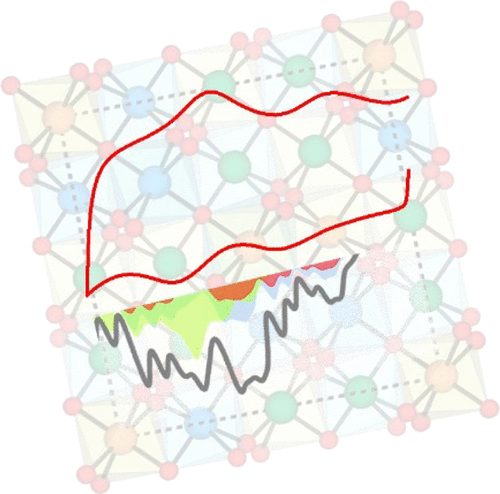当前位置:
X-MOL 学术
›
ACS Appl. Energy Mater.
›
论文详情
Our official English website, www.x-mol.net, welcomes your
feedback! (Note: you will need to create a separate account there.)
Electrocatalytic Site Activity Enhancement via Orbital Overlap in A2MnRuO7 (A = Dy3+, Ho3+, and Er3+) Pyrochlore Nanostructures
ACS Applied Energy Materials ( IF 5.4 ) Pub Date : 2021-01-09 , DOI: 10.1021/acsaem.0c02060 V. Celorrio 1 , D. Tiwari 1 , L. Calvillo 2 , A. Leach 3 , H. Huang 3 , G. Granozzi 2 , J.A. Alonso 4 , A. Aguadero 5 , R.M. Pinacca 6 , A.E. Russell 3 , D.J. Fermin 1
ACS Applied Energy Materials ( IF 5.4 ) Pub Date : 2021-01-09 , DOI: 10.1021/acsaem.0c02060 V. Celorrio 1 , D. Tiwari 1 , L. Calvillo 2 , A. Leach 3 , H. Huang 3 , G. Granozzi 2 , J.A. Alonso 4 , A. Aguadero 5 , R.M. Pinacca 6 , A.E. Russell 3 , D.J. Fermin 1
Affiliation

|
Oxygen electrocatalysis at transition metal oxides is one of the key challenges underpinning electrochemical energy conversion systems, involving a delicate interplay of the bulk electronic structure and surface coordination of the active sites. In this work, we investigate for the first time the structure–activity relationship of A2RuMnO7 (A = Dy3+, Ho3+, and Er3+) nanoparticles, demonstrating how orbital mixing of Ru, Mn, and O promotes high density of states at the appropriate energy range for oxygen electrocatalysis. The bulk structure and surface composition of these multicomponent pyrochlores are investigated by high-resolution transmission electron microscopy, X-ray diffraction, X-ray absorption spectroscopy, X-ray emission spectroscopy (XES), and X-ray photoemission spectroscopy (XPS). The materials exhibit high phase purity (cubic fcc with a space group Fd3̅m) in which variations in M–O bonds length are less than 1% upon replacing the A-site lanthanide. XES and XPS show that the mean oxidation state at the Mn-site as well as the nanoparticle surface composition was slightly affected by the lanthanide. The pyrochlore nanoparticles are significantly more active than the binary RuO2 and MnO2 toward the 4-electron oxygen reduction reaction in alkaline solutions. Interestingly, normalization of kinetic parameters by the number density of electroactive sites concludes that Dy2RuMnO7 shows twice higher activity than benchmark materials such as LaMnO3. Analysis of the electrochemical profiles supported by density functional theory calculations reveals that the origin of the enhanced catalytic activity is linked to the mixing of Ru and Mn d-orbitals and O p-orbitals at the conduction band which strongly overlap with the formal redox energy of O2 in solution. The activity enhancement strongly manifests in the case of Dy2RuMnO7 where the Ru/Mn ratio is closer to 1 in comparison with the Ho3+ and Er3+ analogs. These electronic effects are discussed in the context of the Gerischer formalism for electron transfer at the semiconductor/electrolyte junctions.
中文翻译:

通过轨道重叠在A 2 MnRuO 7(A = Dy 3+,Ho 3+和Er 3+)烧绿石纳米结构中的电催化活性增强
过渡金属氧化物上的氧电催化作用是支撑电化学能量转换系统的关键挑战之一,涉及体电子结构的精细相互作用和活性位点的表面配位。在这项工作中,我们首次研究了A 2 RuMnO 7(A = Dy 3+,Ho 3+和Er 3+)纳米粒子,证明了Ru,Mn和O的轨道混合如何在适当的能量范围内促进氧电催化的高态密度。通过高分辨率透射电子显微镜,X射线衍射,X射线吸收光谱,X射线发射光谱(XES)和X射线光发射光谱(XPS)研究了这些多组分烧绿石的整体结构和表面组成。该材料具有高相纯度(立方fcc,空间群Fd 3d m),其中替换A位镧系元素时M–O键长度的变化小于1%。XES和XPS表明,镧系元素对Mn位以及纳米颗粒表面组成的平均氧化态有轻微的影响。在碱性溶液中,烧绿石纳米粒子对四电子氧还原反应的活性明显高于二元RuO 2和MnO 2。有趣的是,通过电活性位点数密度对动力学参数进行归一化得出结论,Dy 2 RuMnO 7的活性是LaMnO 3等基准材料的两倍。。密度泛函理论计算支持的电化学分布图分析表明,增强的催化活性的起源与Ru和Mn d轨道和O p轨道在导带上的混合有关,这与L的形式氧化还原能强烈重叠。溶液中的O 2。在Dy 2 RuMnO 7的情况下,与Ho 3+和Er 3+类似物相比,Ru / Mn比更接近于1,从而明显增强了活性。这些电子效应是在Gerischer形式主义的背景下讨论的,该形式用于半导体/电解质接合处的电子转移。
更新日期:2021-01-25
中文翻译:

通过轨道重叠在A 2 MnRuO 7(A = Dy 3+,Ho 3+和Er 3+)烧绿石纳米结构中的电催化活性增强
过渡金属氧化物上的氧电催化作用是支撑电化学能量转换系统的关键挑战之一,涉及体电子结构的精细相互作用和活性位点的表面配位。在这项工作中,我们首次研究了A 2 RuMnO 7(A = Dy 3+,Ho 3+和Er 3+)纳米粒子,证明了Ru,Mn和O的轨道混合如何在适当的能量范围内促进氧电催化的高态密度。通过高分辨率透射电子显微镜,X射线衍射,X射线吸收光谱,X射线发射光谱(XES)和X射线光发射光谱(XPS)研究了这些多组分烧绿石的整体结构和表面组成。该材料具有高相纯度(立方fcc,空间群Fd 3d m),其中替换A位镧系元素时M–O键长度的变化小于1%。XES和XPS表明,镧系元素对Mn位以及纳米颗粒表面组成的平均氧化态有轻微的影响。在碱性溶液中,烧绿石纳米粒子对四电子氧还原反应的活性明显高于二元RuO 2和MnO 2。有趣的是,通过电活性位点数密度对动力学参数进行归一化得出结论,Dy 2 RuMnO 7的活性是LaMnO 3等基准材料的两倍。。密度泛函理论计算支持的电化学分布图分析表明,增强的催化活性的起源与Ru和Mn d轨道和O p轨道在导带上的混合有关,这与L的形式氧化还原能强烈重叠。溶液中的O 2。在Dy 2 RuMnO 7的情况下,与Ho 3+和Er 3+类似物相比,Ru / Mn比更接近于1,从而明显增强了活性。这些电子效应是在Gerischer形式主义的背景下讨论的,该形式用于半导体/电解质接合处的电子转移。











































 京公网安备 11010802027423号
京公网安备 11010802027423号